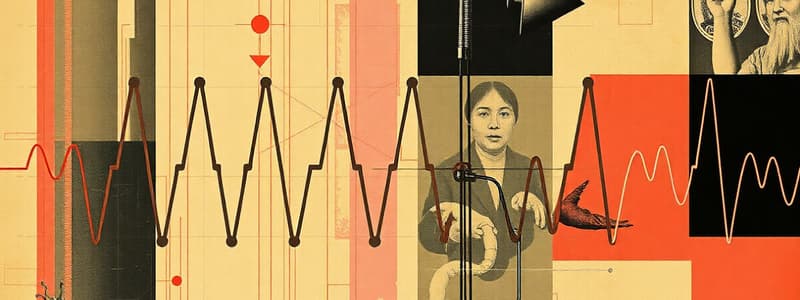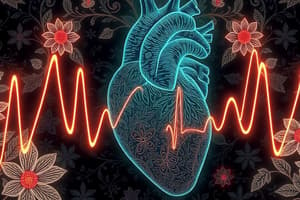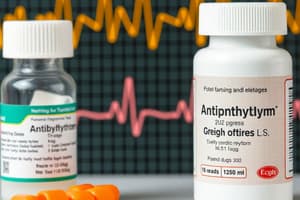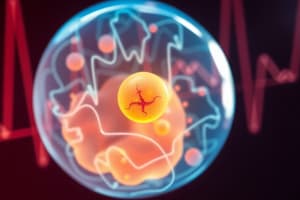Podcast
Questions and Answers
What is the primary purpose of antidysrhythmic medications?
What is the primary purpose of antidysrhythmic medications?
- To simulate the autonomic nervous system exclusively.
- To induce dysrhythmia for controlled therapeutic effect.
- To increase myocardial excitability.
- To treat and prevent disturbances in cardiac rhythm. (correct)
What change in ion distribution causes cardiac cells to become excited?
What change in ion distribution causes cardiac cells to become excited?
- A decrease in sodium outside the cell.
- A static ion distribution.
- An increase in potassium inside the cell.
- A change in the distribution of ions. (correct)
What maintains the electronegative charge difference inside a resting cardiac cell relative to the outside?
What maintains the electronegative charge difference inside a resting cardiac cell relative to the outside?
- The presence of equal ion concentrations.
- The Sodium-Potassium ATPase pump. (correct)
- The consistent distribution of calcium ions.
- The static distribution of sodium ions.
Where is the sinoatrial (SA) node, also known as the 'natural pacemaker', located?
Where is the sinoatrial (SA) node, also known as the 'natural pacemaker', located?
Which component of an electrocardiogram (ECG) represents the electrical activity as it travels through the atria?
Which component of an electrocardiogram (ECG) represents the electrical activity as it travels through the atria?
Which characteristic is typically observed in an ECG of a patient with atrial fibrillation?
Which characteristic is typically observed in an ECG of a patient with atrial fibrillation?
What is the primary mechanism of action of Inotropic drugs?
What is the primary mechanism of action of Inotropic drugs?
Which of the following best describes the function of drugs classified under the Vaughan Williams Classification?
Which of the following best describes the function of drugs classified under the Vaughan Williams Classification?
A medication is classified as a Class Ia Sodium Channel Blocker according to the Vaughan Williams classification. What effect does this medication have on the cardiac action potential?
A medication is classified as a Class Ia Sodium Channel Blocker according to the Vaughan Williams classification. What effect does this medication have on the cardiac action potential?
Which condition would be a contraindication for the use of procainamide?
Which condition would be a contraindication for the use of procainamide?
What is a key consideration when administering lidocaine (Xylocaine), a Class Ib antiarrhythmic, for ventricular dysrhythmias?
What is a key consideration when administering lidocaine (Xylocaine), a Class Ib antiarrhythmic, for ventricular dysrhythmias?
When administering Class Ic antiarrhythmics, which of the following nursing interventions is most crucial?
When administering Class Ic antiarrhythmics, which of the following nursing interventions is most crucial?
A patient with asthma is prescribed a beta-blocker for Atrial Fibrillation needs to understand the drug will not allow what?
A patient with asthma is prescribed a beta-blocker for Atrial Fibrillation needs to understand the drug will not allow what?
Class III antiarrhythmics, such as amiodarone and sotalol, have what mechanism of action?
Class III antiarrhythmics, such as amiodarone and sotalol, have what mechanism of action?
Patients taking amiodarone should be monitored for which potential adverse effect?
Patients taking amiodarone should be monitored for which potential adverse effect?
Verapamil and diltiazem, classified as Class IV antiarrhythmics, are used to treat atrial fibrillation primarily by what mechanism?
Verapamil and diltiazem, classified as Class IV antiarrhythmics, are used to treat atrial fibrillation primarily by what mechanism?
Before administering a dose of diltiazem, a Class IV antiarrhythmic, the nurse should prioritize assessment of what?
Before administering a dose of diltiazem, a Class IV antiarrhythmic, the nurse should prioritize assessment of what?
What is the primary mechanism by which digoxin exerts its therapeutic effect in treating atrial fibrillation/flutter?
What is the primary mechanism by which digoxin exerts its therapeutic effect in treating atrial fibrillation/flutter?
Which assessment finding is most indicative of digoxin toxicity?
Which assessment finding is most indicative of digoxin toxicity?
What is the primary indication for using adenosine?
What is the primary indication for using adenosine?
A nurse is about to administer adenosine for a patient with SVT. What is the most important administration technique to ensure the drug's effectiveness?
A nurse is about to administer adenosine for a patient with SVT. What is the most important administration technique to ensure the drug's effectiveness?
During the administration of antidysrhythmic drugs, what is the importance of monitoring serum potassium levels? Select all that apply.
During the administration of antidysrhythmic drugs, what is the importance of monitoring serum potassium levels? Select all that apply.
When teaching patients about taking antidysrhythmic medications, what should the nurse emphasize regarding the timing of doses?
When teaching patients about taking antidysrhythmic medications, what should the nurse emphasize regarding the timing of doses?
Prior to administering digoxin, what action should the nurse take?
Prior to administering digoxin, what action should the nurse take?
Why is it so important to teach patients, taking beta-blockers, how to take their own radial pulse?
Why is it so important to teach patients, taking beta-blockers, how to take their own radial pulse?
What is a crucial instruction to give patients prescribed an antiarrhythmic medication?
What is a crucial instruction to give patients prescribed an antiarrhythmic medication?
Which of the following statements is an expected outcome of antidysrhythmic therapy?
Which of the following statements is an expected outcome of antidysrhythmic therapy?
Which group would be at higher risk of developing dysrhythmias?
Which group would be at higher risk of developing dysrhythmias?
A patient is prescribed Quinidine. What specific instruction should the patient receive?
A patient is prescribed Quinidine. What specific instruction should the patient receive?
Flecainide is prescribed for what condition?
Flecainide is prescribed for what condition?
Propranolol is prescribed for what reason?
Propranolol is prescribed for what reason?
Prior to administering Amiodarone, what must the nurse consider?
Prior to administering Amiodarone, what must the nurse consider?
What is the purpose of Verapamil?
What is the purpose of Verapamil?
Digoxin is known for what two things?
Digoxin is known for what two things?
Why is Adenosine delivered via fast IV push?
Why is Adenosine delivered via fast IV push?
During therapy, what should the nurse monitor?
During therapy, what should the nurse monitor?
A nurse is administering anti-dysrhythmic medications for the patient. What instruction should the nurse make sure to implement?
A nurse is administering anti-dysrhythmic medications for the patient. What instruction should the nurse make sure to implement?
Which of the following are important steps for teaching anti-dysrhythmic therapy?
Which of the following are important steps for teaching anti-dysrhythmic therapy?
Ensure that the patient knows to notify health care provider of any worsening of dysrhythmia or toxic effects. Which of the following are considered a toxic effect?
Ensure that the patient knows to notify health care provider of any worsening of dysrhythmia or toxic effects. Which of the following are considered a toxic effect?
As the nurse you want to measure and assess for outcome in the BP in hypertensive patients, pulse rate without major irregularities, improved regularity of rhythm, and improved cardiac output. What should the patient be doing?
As the nurse you want to measure and assess for outcome in the BP in hypertensive patients, pulse rate without major irregularities, improved regularity of rhythm, and improved cardiac output. What should the patient be doing?
Flashcards
Dysrhythmia
Dysrhythmia
Any heart deviation from the normal rhythm
Antidysrhythmics
Antidysrhythmics
Used for treatment and prevention of disturbances in cardiac rhythm
Action Potential
Action Potential
Electrical impulse leads to myocardial muscle contraction.
Resting cardiac cell charge
Resting cardiac cell charge
Signup and view all the flashcards
Sodium-Potassium ATPase pump
Sodium-Potassium ATPase pump
Signup and view all the flashcards
Sinoatrial (SA) node
Sinoatrial (SA) node
Signup and view all the flashcards
Electrocardiography (ECG/EKG)
Electrocardiography (ECG/EKG)
Signup and view all the flashcards
P wave
P wave
Signup and view all the flashcards
QRS complex
QRS complex
Signup and view all the flashcards
T wave
T wave
Signup and view all the flashcards
Supraventricular Tachycardia
Supraventricular Tachycardia
Signup and view all the flashcards
Atrial Fibrillation
Atrial Fibrillation
Signup and view all the flashcards
Atrial flutter
Atrial flutter
Signup and view all the flashcards
Ventricular Tachycardia
Ventricular Tachycardia
Signup and view all the flashcards
Ventricular Fibrillation
Ventricular Fibrillation
Signup and view all the flashcards
Inotropic
Inotropic
Signup and view all the flashcards
Chronotropic
Chronotropic
Signup and view all the flashcards
Dromotropic
Dromotropic
Signup and view all the flashcards
Vaughan Williams Classification
Vaughan Williams Classification
Signup and view all the flashcards
Class Ia
Class Ia
Signup and view all the flashcards
Class Ib
Class Ib
Signup and view all the flashcards
Class Ic
Class Ic
Signup and view all the flashcards
Class II: Beta Blockers
Class II: Beta Blockers
Signup and view all the flashcards
Class III
Class III
Signup and view all the flashcards
Class IV: Calcium Channel Blockers
Class IV: Calcium Channel Blockers
Signup and view all the flashcards
Other Antidysrhythmics
Other Antidysrhythmics
Signup and view all the flashcards
Digoxin (Lanoxin)
Digoxin (Lanoxin)
Signup and view all the flashcards
Adenosine (Adenocard)
Adenosine (Adenocard)
Signup and view all the flashcards
Nursing: Patient history
Nursing: Patient history
Signup and view all the flashcards
Nursing: Baseline data
Nursing: Baseline data
Signup and view all the flashcards
Nursing: Electrolyte balance
Nursing: Electrolyte balance
Signup and view all the flashcards
Nursing: Drug levels
Nursing: Drug levels
Signup and view all the flashcards
Nursing: Dosing
Nursing: Dosing
Signup and view all the flashcards
Nursing: Oral medication
Nursing: Oral medication
Signup and view all the flashcards
Worsening dysthymia
Worsening dysthymia
Signup and view all the flashcards
Desired outcome
Desired outcome
Signup and view all the flashcards
Study Notes
- Antidysrhythmic drugs are used for the treatment and prevention of disturbances in cardiac rhythm.
- Dysrhythmia is any heart deviation from the normal rhythm.
Action Potential
- A change in the distribution of ions causes cardiac cells to become excited
- Movement of ions across the cardiac cell's membrane results in an electrical impulse, this spreads across the cardiac cells.
- The electrical impulse leads to contraction of the myocardial muscle.
- The three states are: resting, depolarization, and repolarization
Cardiac Cell
- Inside a resting cardiac cell there is a net negative charge relative to the outside of the cell.
- Resting Membrane Potential is the difference in electronegative charge as a result of uneven distribution of ions (sodium, potassium, calcium) across the cell membrane.
- The Sodium-Potassium ATPase pump maintains this difference.
Electrical Activity of the Heart
- The Sinoatrial (SA) node is the natural pacemaker.
- The Inherent Rate of the SA node is 60-100 BPM
- The Inherent Rate of the AV node is 40-60 BPM
- The Inherent Rate of the Bundle of His is 40-60 BPM
- The Inherent Rate of the Left and Right Bundle Branches are 20-40 BPM
- The Inherent Rate of the Purkinje Fibers are 20-40 BPM
Electrocardiography
-
ECG or EKG shows the electrical activity of the heart.
-
P wave shows electricity to the atria
-
QRS complex shows contraction and electricity to the ventricles
-
In Atrial Depolarization, the P wave shows that the atria are contracting
-
In Ventricular Repolarization, the T wave shows that the ventricles are relaxing
-
In Ventricular Depolarization, the QRS Complex shows that the ventricles are contracting
-
Supraventricular Tachycardia includes a PR interval thats too small to ineligible
-
Atrial Fibrillation includes no p-waves
-
Atrial Flutter includes a predictable pattern
Ventricular Dysrhythmias
- Ventricular Tachycardia
- Ventricular Fibrillation
Antidysrhythmic Drugs
- Mechanisms of Action for Antidysrhythmic Drugs include: prolong the AV node, increase or reduce conduction speed, alter ectopic pacemakers and SA node, reduce myocardial excitability, and simulate autonomic nervous system
- Multiple different classes of medications are used
- Sodium Channel Blockers
- Beta-Adrenergics
- Potassium Channel Blockers
- Calcium Channel Blockers
- Additional Classes
- Inotropic means force of contraction
- Chronotropic means rate of contractions
- Dromotropic means electrical current
Vaughan Williams Classification
- A System commonly used to classify antidysrhythmic drugs
- Based on the electrophysiologic effect of particular drugs on the action potential
- The classifications are:
- Class I: Sodium Channel Blocker
- Class Ia
- Class Ib
- Class Ic
- Class II: Beta Blocker
- Class III: Potassium Channel Blocker
- Class IV: Calcium Channel Blocker
- Other:
- Digoxin
- Adenosine
- Class I: Sodium Channel Blocker
Drugs Affecting the Cardiac Action Potential
- Class 1 contains Na+ channel blockers
- Quinidine and Procainamide are moderate
- Lidocaine and Phenytoin are weak
- Flecainide and Propafenone are strong
- Class 2 contains beta-blockers
- Propranolol
- Metoprolol
- Class 3 contains K+ channel blockers
- Amiodarone
- Sotalol
- Class 4 contains Ca2+ channel blockers
- Verapamil
- Diltiazem
Vaughan Williams Class Ia: Sodium Channel Blocker
- Procainamide (Proneystl), Quinidine gluconate, and disopyramide (Norpace) are Class Ia drugs.
- These drugs work by blocking sodium (fast) channels and delays repolarization
- Used for Atrial fibrillation, Atrial flutter, Ventricular Tachycardia, Supraventricular Tachycardia, Wolff-Parkinson-White Syndrome
- Adverse Effects of procainamide: Systemic Lupus Syndrome, Neutropenia/Thrombocytopenia, Cardiotoxicity, and Hypotension
- Contraindications/Precautions include: Pregnancy Risk Category C and Liver or renal disorders
- Medication/Food Interactions include: Antidysrhythmics and Antihypertensives
- When administering, do not crush or chew sustained-released medications
Vaughan Williams Class Ib: Sodium Channel Blocker
- Class Ib drugs include lidocaine (Xylocaine), mexiletine (Mexitil), and tocainide (Tonocard)
- Decrease electrical conduction and Increase rate of repolarization.
- Class IB drugs are used for Ventricular Dysrhythmias
- Class Ib drugs can cause the Adverse Effect of CNS: twitching, convulsions, and respiratory depression.
- Contraindications: Liver and renal dysfunction
- Beta Blockers and Phenytoin increase serum levels of lidocaine
- Nursing Administration involves IV administration usually started with a weight based dose and then a maintenance dose
- Should not be used for no more than 24 hours
Vaughan Williams Class Ic: Sodium Channel Blocker
- Class Ic drugs include propafenone (Rhythmol), flecainide (Tambocor)
- Mechanism of Action includes: Decease electrical conduction, Decrease excitability, Increase rate of repolarization
- Class Ic is used for Supraventricular Tachycardia
- Adverse Effects include: Bradycardia, Heart failure, Dizziness, Weakness
- Contraindications for use include: Severe heart failure, Severe hypotension
- Medication interactions include: Digoxin, oral anticoagulants, beta blockers
- Monitor ECG during treatment, and for bradycardia and hypotension.
- Take medication with food, do not crush
Vaughan Williams Class II: Beta Blocker
- Propranolol hydrochloride (Inderal), esmolol hydrochloride (Brevibloc), metoprolol (Lopressor) are Class II drugs
- Mechanism of Action:
- Prevent sympathetic nervous system stimulation of the heart
- Decrease heart rate, slow rate of conduction through the SA node
- Used for Atrial fibrillation, Atrial flutter, SVT
- Adverse Effects: Bradycardia, hypotension, impotence
- Contraindications: Severe, heart failure, asthma
- Medication Interactions include: Verapamil and Diltiazem, can mask the hypoglycemic effect of insulin
- Nursing Administration includes: Take apical pulse daily. Administer IV form slowly.
Vaughan Williams Class III: Potassium Channel Blockers
-
Class III drugs include: amiodarone (Cordarone, Pacerone), sotalol (Betapace), dofetilide (Tikosyn)
-
Mechanism of Action includes: Prolong the action potential and refractory period of the cardiac cycle, decrease rate of repolarization, decrease electrical conduction, decrease contractility
-
Used for: Atrial Fibrillation by oral route, recurrent ventricular fibrillation, ventricular tachycardia
-
Contraindications for Class III includes: AV block, and bradycardia, liver, thyroid or respiratory dysfunction
-
Medication/Food Interactions includes: Diltiazem, digoxin, and warfarin, and grapefruit juice
-
Nursing Administration includes: Amiodarone is highly toxic. Adverse effects may continue until medication is discontinued. Provide patients with information regarding toxicities.
Vaughan Williams Class IV: Calcium Channel Blockers
- Class IV drugs include verapamil (Calan), diltiazem (Cardizem)
- Mechanism of Action: Depress depolarization and decrease myocardial oxygen demand, decrease force of contraction, decrease heart rate, and slow rate of conduction through SA and AV Node
- Used for atrial fibrillation, Atrial flutter, and SVT
- Adverse Effects include: Bradycardia, hypotension, constipation
- Contraindications: SA/AV dysfunction and Heart blocks
- Nursing Administration includes: May cause orthostatic hypotension, change positions slowly, notify the provider for peripheral edema, or shortness of breath
Vaughan Williams Classification: Other Antidysrhythmics
- These have properties of several classes and are not placed into one particular class
- These include Digoxin and Adenosine
Unclassified Antidysrhythmics
-
Digoxin (Lanoxin) is used for advanced heart failure
-
It slows conduction between the SA & AV node
-
Used to slow the rate in atrial fibrillation/flutter
-
Can be administered PO or IV
-
Long half life and duration of action
-
High risk for toxicity: can lead to renal impairment
-
Follow Digoxin levels to determine dose
-
Adverse Effects: Cardiac arrhythmias and Yellow halos
-
Antidote: Digoxin Immune Fab (Digibind)
-
Adenosine (Adenocard) corrects only AU node problems
-
It slows conduction through the AV node
-
Used to convert paroxysmal supraventricular tachycardia to sinus rhythm
-
Very short half-life, less than 10 seconds
-
Only administered as fast IV push (6mg)
-
May cause asystole for a few seconds
-
Other adverse effects minimal
Nursing Implications for administering Antidysrhythmics Drugs
- Obtain a thorough drug and medical history
- Measure baseline BP/P, I & O, and cardiac rhythm
- Measure serum potassium levels before initiating therapy, due to renal function
- During therapy, monitor cardiac rhythm, heart rate, BP, general well-being, skin color, temperature, heart and lung sounds.
- Assess plasma drug levels as indicated
- Monitor for toxic side effects
- Instruct patients to take medications as scheduled and not to skip doses or double up for missed doses
- Instruct patients to contact their physician for instructions if a dose is missed
- Instruct patients not to crush or chew oral sustained-release preparations
- Administer IV infusions with an IV pump
- Teach patients taking beta-blockers, digoxin, and other drugs how to take their own radial pulse for 1 full minute, and to notify their physician if the pulse is less than 60 beats/minute before taking the next dose
- Ensure that the patient knows to notify health care provider of any worsening of dysrhythmia or toxic effects – this is due to changes in cardiac output, shortness of breath, Edema, Dizziness, Syncope, Chest pain, Gl distress, Blurred Vision, and Edema
Expected Outcomes of Antidysrhythmic Drugs
- Decreased BP in hypertensive patients
- Decreased edema
- Decreased fatigue
- Regular pulse rate
- Pulse rate without major irregularities
- Improved regularity of rhythm
- Improved cardiac output
- Goals should include target: HR and BP
SDOH
- Older adults with HTN, heart failure, diabetes and thyroid disease are more at risk of developing dysrhythmias
- Lidocaine - $5 for 20 doses
- Propranolol – 30 day supply $30-$80
- Digoxin - $50 for 100 tablets
Studying That Suits You
Use AI to generate personalized quizzes and flashcards to suit your learning preferences.




